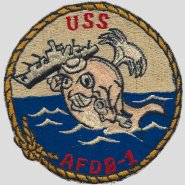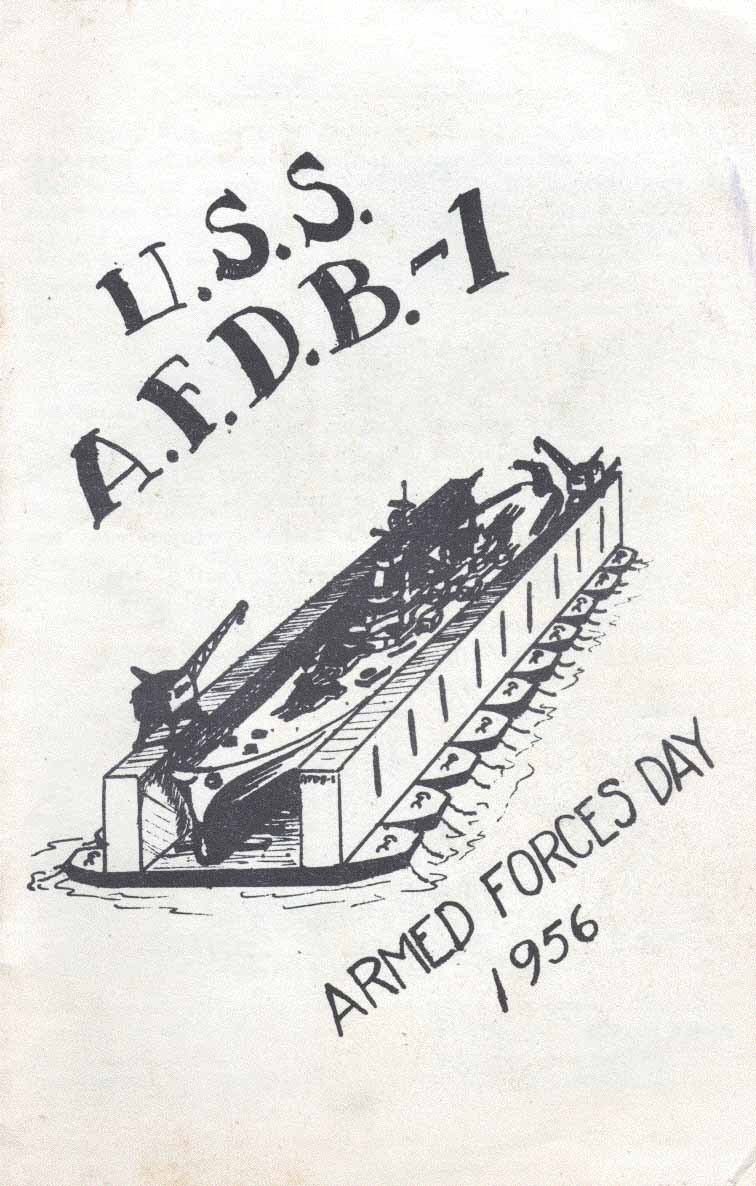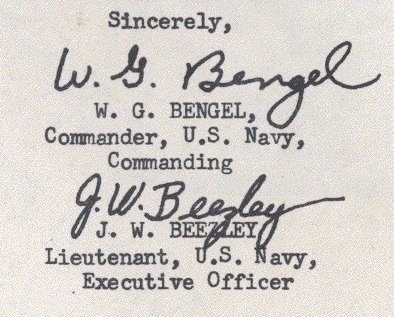NavSource Online: Service Ship Photo Archive

Contributed by Mike Smolinski
USS AFDB-1

ARMED FORCES DAY
MAY 19, 1956
Please report any broken links or trouble you might come across to the Webmaster. Please take a moment to let us know so that we can correct any problems and make your visit as enjoyable and as informative as possible.


ARMED FORCES DAY
MAY 19, 1956
On this 1956 Armed Forces Day Observance, it is hoped that your visit aboard the U.S.S. AFDB-1, Guam, Mariana Islands, will be an interesting and educational success in the Navy's aim to bring you in closer contact with your Navy. It is the mission of the officers and men of this vessel to explain to you anything you may have doubts about.
It is believed that your escorted tour of the drydock plus the pictorial display will give you this vessel's mission to the fleet at forward area's, both in time of war and peace,

HISTORY OF U.S.S AFDB-1
The U.S.S. AFDB-.1 (formerly ABSD-1) is the first of its class of advance base sectional drydocks, built by the Bureau of Yards and Docks to dock the largest combat ships now afloat and, with modifications, those larger aircraft carriers now in construction. Following the requirements set forth by the Bureau of Yards and Docks, Frederic R. Harris, Inc., the designing engineers, developed designs which permitted rapid construction, imperative under war conditions. A number of companies contracted for the construction of these drydock sections, the completed USS AFDB-1 having been built in five different shipyards in the United States, ranging from Morgan City, Louisiana, to Everett, Washington. These were the Everett Pacific Company, Everett, Washington (two sections), Pollock Stockton Shipbuilding Company, Stockton, California, (three sections), Chicago Bridge and Iron Company, Eureka, California, (one section), Pacific Bridge Company, Alameda, California, (two sections), and Chicago Bridge and Iron Company, Morgan City, Louisiana, (two sections).
Each dock section, called an AFD is composed of a compartmentalized pontoon upon which are mounted two folding wingwalls. The section, which has its dependent power plant of two diesel driven generators, pumping plants, evaporators, messing and berthing quarters, carries a crew of about fifty men. While in sailing position, the wingwalls are folded into horizontal position, thus reducing wind resistance and enabling the section to be towed more readily. Extended sea voyages can be successfully undertaken in the sailing position, which necessitates the temporary installation of pilot house, life rafts, visual and radio communications, mooring tackle, and other seagoing gear.
The AFD-7 was the first section completed. Following the successful submergence and wingwall raising tests by flotation method held on this section in Everett, Washington, a combined Christening and Commissioning
-1-
Ceremony took place on 10 May 1943. Mrs. Andrew R. Mack, wife of the first Commanding Officer, sponsored the USS ABSD-1. In accordance with instructions from the Chief of Naval Operations, Captain Andrew R. Mack placed the ship in commission and assumed command of all sections comprising the USS AFDB-1 (then ABSD-1).
By being made readily available to battle damaged ships relatively close to the scene of action, the AFDB type drydock furnished a new service to the capital ships of the United States Fleet during the last war. As a matter of recent history, the USS AFDB-1 was reactivated at Pearl Harbor Naval Shipyard during the first half of 1951 and was commissioned on 2 June 1951.
Following the outbreak of the Korean action, it was decided that the time was propitious for the reactivation of a large drydock. Accordingly, it was determined to place the USS AFDB-1 into commission, and reactivation work was commenced at the Pearl Harbor Naval Shipyard in January 1951. On 2 June, the USS AFDB-1. was recommissioned at Pearl Harbor and on 4 June the first two sections in company with two auxiliary craft departed Pearl under tow for Guam, Mariana Islands. From the initial tow date until 12 October 1951, when Sections GEORGE and HOW, the final two sections arrived at Apra Harbor, ten sections and six companion craft were dispatched in several group tows to the assembly location. One week after the arrival of the first two sections, the operation of raising the wingwalls on Section ABLE was commenced and early in September the marriage of the first two units and assembly of the drydock itself got underway. The ten sections of the drydock were completely assembled in January 1952. A series of submergence tests were conducted following assembly for shakedown of the crew, structure and machinery. On 5 April 1952 during a one day final lift test the USS AFDB-1 drydocked the USS WISCONSIN (BB64). On 1 September 1952, in view of" the prevailing world situation. the USS AFDB-1, though still remaining in commission, was placed in an "Active in Reduced Service" status.
-2-
Two methods for raising and lowering the 400 ton. wingwalls have been successfully used; the flotation method, by which the flooding and pumping of pontoon wingwalls at a predetermined depth and angle enables them to be raised or lowered, and the jacking method, by which two ten ton columns and hydraulic jacks raise and lower them.
After the assembly of two or more sections has been achieved and the moorings laid, the transfer of a 250 ton Gantry Crane to each wingwall is made. With pintles and gudgeons, wedges, and welded splice plates joining the sections and making them one unit, other features are added, namely a sloping ladder and elevator on the outboard sides of the wingwalls at either end of the dock; flying bridges at both ends to make a continuous platform around the dock at wingwall height; a fifty foot outrigger at each end on the pontoon deck to extend the working space of the dock another 100 feet; installation of shops, offices, living spaces, and recreation facilities inside the wingwalls on the safety deck.
The USS AFDB-1 is capable of docking the largest ship afloat, and by that token is itself the largest afloat. At the same time., as a mobile unit, the dock may be moved by sections through the Panama Canal from one advanced base to another. It, is also self-docking. Two or more assembled sections may dock a third section.
As each section is in itself a complete unit with identical compartmentation, the Navy Standard Divisional designations in regards to numbering and lettering of spaces are not used. All spaces such as buoyancy chambers, ballast tanks, passageways, etc., are prefixed with the letter designating the section of the assembled dock. Starboard spaces are numbered with odd numbers, and port spaces with even numbers.
-3-
GENERAL INF0RMATION
Overall length of dock: 927 feet (including fifty foot outrigger at each end).
Length of each pontoon (width of the' assembled dock), 256 feet
Height of wingwalls: 56 feet above the dock basin.
Width of wingwalls: 20 feet
Width of each pontoon: 80 feet
Depth of pontoon: 28 feet
Distance between wingwalls: 140 feet.
Moorings: 40 fifteen ton anchors with about 150 fathoms of 3" chain on each anchor
Armament: None installed at present .
-4-
| Back to the Navsource Photo Archives Main Page | Back To the Service Ship Type Index | Back To The Dry Dock Photo Index | Back To The AFDB-1 Main Page |
| Comments, Suggestions, E-mail Webmaster. |
|
This page is created and maintained by Gary P. Priolo |